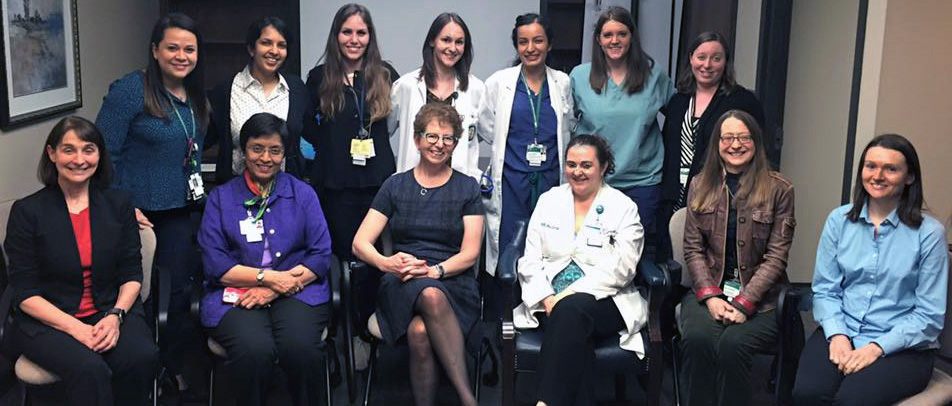UAB’s Division of Pulmonary, Allergy, and Critical Care Medicine recently held its first Women in Pulmonary and Critical Care Medicine symposium. This symposium, which hosted a lecture by Medical University of South Carolina’s Dr. Lynn Schapp, focused on the unique issues faced by women in pulmonary medicine. These issues included professional promotion and networking, work-life balance, the overall position of women in pulmonary medicine, and the value of professional social bonds.
“The symposium was quite good. The discussion was honest and reinforcing,” professor emeritus Nancy Dunlap, MD, PhD said. “The symposium also reinforced how we can help others, get involved, and make our voices heard.”
“We covered topics including assembling a strong NIH bio sketch or CV and strategies to be successful in professional requests” said Jennifer Trevor, MD. “We discussed a lot of very practical and sound career advice that could be used by anyone.”
A sizable portion of the symposium was dedicated to balancing the difficulties of pulmonary medical practice and life outside of the hospital.
“There was a very good discussion on the importance of balance,” Dr. Dunlap said. We made sure to discuss how to balance our never-ending medical work with a healthy personal and home life.”
“While we touched on issues like having children and the impact that can have on your work, the speaker did not emphasize this topic.” Dr. Trevor elaborated. “I appreciate that it was not emphasized because I think doing so continues to reinforce a stereotype.”
Symposium attendees also discussed the position of women in pulmonary medicine, as well as the future role of female pulmonary physicians.
“Pulmonary medicine is widely held as a male-dominated profession. I have a few ideas as to why that is,” Dr. Trevor said. “Typically, pulmonary fellows and practicing physicians have long hours and lots of active work. That can mean a loss of personal time. Many women who want to enter medicine either don’t want to lose that time or are discouraged from doing so. ”
“When I came up through the ranks, pulmonary physicians had a reputation for being very tough, very strong, and very uncompromising. They did the work that others couldn’t,” Dr. Dunlap explained. “Pulmonary medicine has always been seen as a very intense, physical specialty, with a lot of active, physical treatment therapies and procedures. Women aren’t usually encouraged to practice that kind of intense, physical medicine.”

Both Dr. Dunlap and Dr. Trevor believe that the number of women in pulmonary medicine will increase. They see this increase as both inevitable and necessary.
“Medical school enrollment numbers have only recently started to balance between men and women. I think as more women enter medicine as a whole, there will be more women going into pulmonary medicine as a result,” Dr. Trevor said.
“A division attracts the most qualified women when it has good female representation in your faculty. It’s easy to assume that if there are no women in a division’s faculty, then that division is not welcoming to women,” Dr. Dunlap remarked. “Having role models who show that there are women clinicians who can do the work and maintain their personal lives is essential for recruiting and motivating women to work in this specialty.”
Dr. Dunlap sees growing the number of young faculty members in leadership positions as essential.
“I do believe that there is a tendency in every professional field to believe that women, particularly when they have families, would have balance issues. As a result, women aren’t put in leadership positions and fall behind their male peers,” Dr. Dunlap said. “If you haven’t held those leadership positions at a certain point, you fall behind professionally and can’t catch up. That’s why it is very important to nominate young faculty members to professional organizations.”
Dr. Dunlap and Dr. Trevor also believe that increasing the presence of female pulmonary physicians will lead to more robust, helpful, and open social bonds.
“If you don’t have a strong group of women in the same age group supporting you, you don’t have the avenue to talk about unique issues. For example, when I was pregnant, it was the first faculty pregnancy in the division,” Dr. Dunlap said. “There was nobody to talk with about that. I had experiences that my male colleagues never really felt stressed by. It would have been nice to have a group that understood those issues.”
“We don’t have many women in our faculty, so it’s nice for the women that are here to form stronger social bonds,” Dr. Trevor said. “As our female representation grows, we get more chances to form those social bonds and the more important it becomes to promote those bonds.”
This symposium, which both Dr. Dunlap and Dr. Trevor hope is the first of many, displays UAB Pulmonary’s dedication to reflection and self-improvement. For a first-time event, this symposium was impressively successful. The symposium drew many attendees, with physicians, fellows, and medical students all in attendance. This level of interest, combined with the important topics the symposium discussed, suggests a strong future for this symposium.